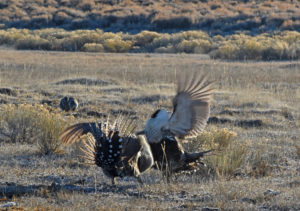For immediate release, May 8, 2020
Media contacts:
John Persell, Western Watersheds Project (503) 896-6472; jpersell@westernwatersheds.org
Mike Garrity, Alliance for the Wild Rockies (406) 459-5936; wildrockies@gmail.com
Jason Christensen, Yellowstone to Uintas Connection (435) 881-6917; jason@yellowstoneuintas.org
WASHINGTON, D.C. – Today, conservation groups moved for a preliminary injunction to protect Endangered Species Act-listed animals in the Upper Green River area of Wyoming’s Bridger-Teton National Forest. Western Watersheds Project, Alliance for the Wild Rockies, and Yellowstone to Uintas Connection asked the Court to immediately prevent the unlawful killing of threatened grizzly bears in response to conflicts with domestic livestock.
In 2019, the U.S. Fish and Wildlife Service signed a biological opinion authorizing the lethal removal of 72 grizzly bears over ten years within the Forest Service’s Upper Green River Area Rangeland Project allotments.
“It’s unthinkable that the government would allow so many grizzlies to be killed merely for the sake of livestock grazing on the national forest,” said John Persell, staff attorney with Western Watersheds Project. “Grizzlies are still listed under the Endangered Species Act because they are still at risk. Killing so many bears, including an unspecified number of females, reverses the species’ recovery and is contrary to law.”
The number of conflicts between grizzly bears and livestock in the Upper Green River area is much higher than other parts of the Greater Yellowstone Ecosystem. 35 grizzly bears have been killed on the Upper Green River area allotments since 2010.
“The grazing management practices on these allotments are certain to put more grizzlies in harm’s way,” said Jason Christensen, director of Yellowstone to Uintas Connection. “Rather than require permittees to be proactive about preventing conflict, the Forest Service has instead authorized dozens of these at-risk bears to be killed.”
Today’s legal action is aimed at preventing imminent and irreparable injury, since grazing is slated to begin on June 14th across six allotments in the Upper Green River area, and livestock-related bear killings have already begun.
“Under this decision, the agencies have already killed at least three bears in this area for doing what predators do, which is to eat the available food in their habitat,” said Mike Garrity, executive director of the Alliance for the Wild Rockies. “By killing bears the government isn’t protecting grizzlies in accordance with the ESA,” Garrity continued. “No grizzlies should be killed for cows. We have millions of cattle in this country but only about 700 grizzlies in the Greater Yellowstone ecosystem.”
Livestock operations authorized by the Forest Service also entail harmful cattle herding and trailing through the Kendall Warm Springs exclosure, which is meant to protect the only known habitat in the world for the endangered Kendall Warm Springs dace, a small fish. The conservation groups also asked the Court to halt this practice to prevent harm to this species.
The plaintiff groups are represented by John Persell of Western Watersheds Project, Kristine Akland of Akland Law Firm of Missoula, Montana, and David Bahr of Bahr Law Offices, PC, of Eugene, Oregon.






